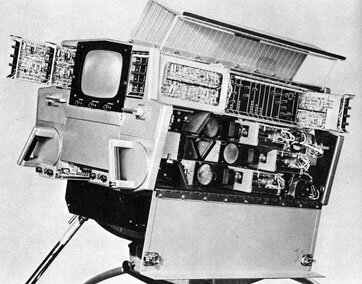GETTING A HANDLE ON THE SUBJECT...
Operating the TK-42 was also presenting a challenge to the production people.

"We looked at the rear zoom and focus controls and realized they weren't practical, but when you put external controls on the pan handles and connected them to the zoom with cables, there was a copper band up inside the lens that would breakso right in the middle of a show you'd go to zoom and it would stick on that focal lengthand you couldn't zoom any more. You had to completely disassemble the camera, take the lens out, ship it back and get it refurbished. If we got 3 or 4 months of service out of those zoom lenses in the first year, we were lucky. It got to the point that RCA had a loaner that we were constantly using while our TK-42 was being fixed. It was known to be a loser throughout the industry."
In fact, the NBC network never used the TK-42 at their facilities in New York and Los Angelesthey held onto the aging TK-41 cameras until RCA delivered the next generation of camera using 3 tube plumbiconsthe TK-44. "After the TK-42s were in use, we'd get about 4 or 5 mods per week.," relates Adrian. "The instructions were incomplete and it was a bad time for the RCA research and development people. We eventually realized that cameras actually worked worse after the mod was installed!"
HAVE MOBILE UNIT...WILL TRAVEL
Shortly after WTVT went full-color, Chief Engineer Bill Witt moved up to Gaylord's newest acquisition in Milwaukee, WUHF (Later rechristened WVTV), and Lawton Metcalfe was promoted to Witt's former position. Adrian was appointed Engineering Maintenance Supervisor in June, 1966.
The new color mobile unit was originally equipped with
General Electric cameras.
With the studio color-equipped, the time had come to put the old 1960 remote unit out to pasture and create a new, color mobile unit. But the experience with the TK-42 prompted engineering to look at other manufacturers for color cameras. "Everybody liked the color that was on Hee Haw, which were General Electrics in the early years," explains Adrian. "Plumbicons had a trailing problem with the red tube, and the G.E.s had solved the problem, sotwo General Electric PE-350s were put on the truck. The new mobile unit was a one-piece truck with an underpowered engine that would hardly make it up the hill. Some major modifications were made to the truck to allow for camera storage underneath. The unit was pretty popular, and was used for station remotes and a syndicated program taped at Cypress Gardens, 'Day of Discovery.' The Norelco PC-70s came along later, and we changed to them in the summer of 1970. The mobile unit was used up until the late 1970s, when Gaylord decided to get out of the remote truck business. "